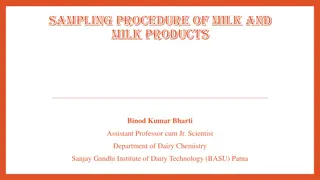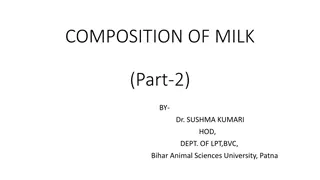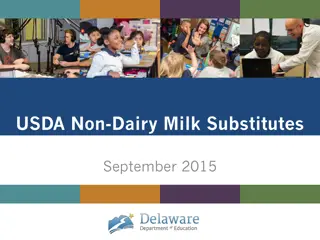High Tea Surrey bc
Craving a unique high tea experience in Surrey, BC? Tokyo Mithaiwala is your ultimate destination for an exceptional tea affair that transports you to the heart of culinary excellence. Our thoughtfully curated menu unfolds an exquisite array of traditional sweets and savory delights, promising to im
3 views • 1 slides
Plant-based Milk Market: Application and Benefits
Meticulous Research\u00ae\u2014a leading global market research company, published a research report titled \u2018Plant-based Milk Market by Type (Almond Milk, Soy Milk, Coconut Milk, Oat Milk, Rice Milk), Formulation (Unflavored, Flavored), Distribution Channel (B2B, B2C [Modern Groceries, Convenie
1 views • 3 slides
Understanding Condensed Milk: A Comprehensive Overview
Condensed milk is cow's milk from which water has been removed, typically found with added sugar. There are two types: unsweetened and sweetened condensed milk. The product has a long shelf-life due to its high sugar content. It is used in various dessert dishes worldwide and can be a substitute for
3 views • 11 slides
Insights into Milk Composition and Processing
Worldwide, milk is collected from various animals such as cows, goats, sheep, yaks, and water buffalo. The composition of milk includes water, lactose, butterfat, protein, and minerals, each playing a vital role in its nutritional value. The butterfat content determines the richness of dairy product
7 views • 41 slides
Plant-based Milk Market, Projected to Reach $52.54 Billion by 2031
Plant-based Milk Market Size, Share, Forecast, & Trends Analysis by Type (Almond Milk, Soy Milk, Coconut Milk, Oat Milk, Rice Milk), Formulation (Flavored), Distribution Channel (B2B, B2C [Modern Groceries, Convenience Store]) - Global Forecast to 2031\n
0 views • 3 slides
Flavoured Milk: Delicious Varieties and Health Benefits
Flavoured milk is a popular dairy drink enjoyed by children and adults alike. It is made by adding flavorings and sugar to milk, resulting in delicious options like Chocolate, Marshmallow, Cherry, and more. Despite containing added sugar, flavoured milk retains the essential nutrients of plain milk
0 views • 11 slides
Tea Cultivation in India: A Comprehensive Overview
Tea cultivation in India has a rich history dating back to 1823 when British settlers discovered wild tea plants in Assam. Today, India is the second-largest tea producer globally. Major tea-producing regions include Assam, West Bengal, Tamil Nadu, and Kerala. The ideal conditions for tea growth inc
0 views • 11 slides
Proper Sampling Procedure of Milk and Milk Products
Proper sampling of milk and milk products is crucial for accurate chemical analysis. This article covers the sampling procedures for various dairy products like milk, cream, paneer, ghee, and more. It emphasizes the importance of experienced personnel, sterile equipment for bacteriological testing,
1 views • 28 slides
Overview of Market Milk: Types, Standards, and Microbiological Quality
Market milk encompasses various types such as standardized, full cream, and skimmed milk, each with specific standards and microbiological requirements. Factors affecting microbiological quality include raw milk quality and processing steps. Understanding these aspects is crucial for maintaining the
0 views • 22 slides
Sensory Evaluation of Milk Powder in Dairy Technology: Flavors and Characteristics
Sensory evaluation is crucial for determining the quality and shelf life of milk powder products. This study focuses on sensory analysis methods to identify flavors and physical characteristics of whole milk powder, skim milk powder, and malted milk. It discusses common flavor defects, texture varia
2 views • 12 slides
Understanding Milk Standardization: Methods and Objectives
Milk standardization is the process of adjusting milk constituents to meet legal requirements and ensure product uniformity. This involves reducing butterfat content through addition of skim milk or removal of cream. The primary objectives include legal compliance, uniform product quality, and effic
0 views • 13 slides
Understanding Condensed Milk: Types, Properties, and Manufacturing Process
Condensed milk is a dairy product made by evaporating water from whole or skimmed milk, with or without sugar. There are various types such as sweetened and unsweetened, each with specific requirements for milk fat content and sugar levels. The physico-chemical properties of condensed milk include f
2 views • 5 slides
Understanding the Composition and Nutritive Value of Milk
Milk composition varies due to factors like species, breed, feeding, and more. It contains essential nutrients like protein, minerals, and vitamins. Milk is a rich source of calcium, phosphorus, and vitamins, essential for overall health. The energy value of milk constituents varies, with milk fat h
0 views • 7 slides
Understanding the Composition of Milk by Dr. Sanjeev Kumar
Milk, a vital substance for mammalian offspring, is a complex fluid composed of water, fat, protein, lactose, minerals, vitamins, and enzymes. Dr. Sanjeev Kumar, an Associate Professor and Head of the Department of Dairy Technology at SGIDT, enlightens us on the various constituents of milk, market
0 views • 11 slides
Understanding Milk Freshness and Quality Control
Milk freshness is crucial for maintaining optimal nutrient composition and preventing excessive acidity due to microbial activity. Various tests and analyses are conducted to assess the freshness and appropriateness of milk for further processing, with titration methods being a common approach for m
2 views • 7 slides
Milk Preservation Techniques and Methods
Milk can be preserved using various techniques such as chilling, pasteurization, and chemical preservation methods like hydrogen peroxide. The shelf life of milk can be extended by cooling or utilizing the lactoperoxidase system. Germicidal properties of fresh milk and naturally occurring inhibitory
3 views • 16 slides
Physico-Chemical Changes in Milk and Milk Products During Processing and Storage
Physico-chemical changes occur in milk and milk products during processing and storage, including alterations such as salt precipitation, protein denaturation, and flavor changes. Heat treatments like autoclaving and freezing impact the composition, properties, and flavor of milk. Understanding thes
0 views • 9 slides
Understanding Milk Judging and Sensory Evaluation in Dairy Technology
In the dairy industry, milk judging involves assessing quality based on various attributes, while sensory evaluation encompasses the use of all five senses to gather information. Milk is graded into categories like Grade I, II, and III based on factors like off-flavors and foreign materials. Evaluat
0 views • 13 slides
Special Milk Program Requirements for Indiana Camps
Special Milk Program Requirements for Camps under the Indiana Department of Education School Nutrition Programs include details on reimbursement for paid milk only options, nutrition requirements for fluid milk consumption, recordkeeping guidelines, camp worksheets, CNPweb monthly claim procedures,
4 views • 16 slides
Understanding Condensed and Evaporated Milk Products
Condensed milk is made by evaporating water from whole or skimmed milk, possibly with added sugar, while evaporated milk involves evaporating water from milk and sterilizing it. Standards for their fat and solids content are set by FSSR. Preparation involves varying steps like reception, cooling, fi
0 views • 15 slides
Cream Separation Methods and Principles in Dairy Technology
Cream separation in dairy technology involves various methods such as centrifugal and gravity methods. The purpose is to obtain fat-reduced or fat-free milk, concentrate milk fat, standardize fat content, and recover fat. The separation is based on the principle that milk fat is lighter than skim mi
1 views • 12 slides
Understanding the Physico-Chemical Properties of Milk - Part 1 by Dr. Sushma Kumari
Physical and chemical properties of milk including its physical state, acidity levels, pH, density, freezing point, color, and flavor are discussed in detail in this informative article by Dr. Sushma Kumari from Bihar Animal Sciences University. Key points covered include the nature of milk constitu
0 views • 7 slides
Exploring Dairy Products and Milk Varieties
The article delves into the realm of dairy products, focusing on various types such as milk, cheese, yogurt, cream, and butter. It explains how milk, produced by mammals like cows and sheep, serves as a vital source of nutrition for infants. Additionally, it details different heat treatments applied
3 views • 75 slides
Concurrency in Milk Management Scenario
The scenario explores a comical tale of roommates, A and B, dealing with the dilemma of milk shortages and excessive milk. Through a series of notes, images, and code snippets, the story unfolds as the roommates navigate buying and storing milk, with a touch of concurrency illustrated in their actio
0 views • 8 slides
Delamere Dairy - Leading the Way in Goat Milk Products
Delamere Dairy, founded by Roger and Liz Sutton, is a renowned business specializing in goat milk products. With a turnover of £20 million in 2015, they offer a range of dairy and dairy alternatives, including fresh goat's milk, cheese, butter, UHT milk, yogurt, and more. Their business model focus
1 views • 10 slides
Exploring the Biochemistry of Milk: Components, Processing, and Health Benefits
Delve into the intricate world of milk biochemistry with a focus on its components, processing methods, and health implications. Learn about the proteins, fats, carbohydrates, minerals, and vitamins present in milk, as well as how they contribute to its complex nature. Discover the various processes
0 views • 15 slides
Understanding the Special Milk Program (SMP): Eligibility, Reimbursement, and Requirements
The Special Milk Program (SMP) encourages milk consumption among children in care settings, administered by the Department of Public Instruction (DPI) in Wisconsin. Participating agencies receive federal reimbursement for milk served to eligible children. This program operates year-round for non-sch
0 views • 34 slides
Essential Tea and Coffee Making Skills for Cadets
Learn why cadets make tea and coffee, the importance of good tea and coffee-making skills, common complaints, brewing instructions, the milk controversy, and the impact of a well-made cup of tea on staff morale.
0 views • 14 slides
Survey Results on Tea Preferences Among 20 People
A survey of 20 people revealed that 4 liked milk and sugar in their tea, 8 preferred only milk, 6 favored only sugar, and 2 liked neither milk nor sugar. The information is represented in a Venn diagram. Additionally, the probability of a randomly chosen person preferring milk is 12/20. The probabil
0 views • 18 slides
USDA Non-Dairy Milk Substitutes September 2015
Explore the USDA regulations and guidelines for non-dairy milk substitutes, focusing on cow's milk and soy milk. Learn about food allergies versus intolerances and the importance of approved substitutions. Understand the serving regulations for milk in CACFP meals and the accommodations required for
1 views • 11 slides
Importance of Feeding Infants with Breast Milk and Iron-Fortified Formula
Breast milk and iron-fortified infant formula are recommended for infants to meet their nutritional needs and support optimal development. Breast milk offers numerous health benefits, protecting infants from illnesses and reducing the risk of obesity. Iron-fortified formula is a suitable alternative
0 views • 23 slides
Exploring the Chemistry and Culture of Tea: A Comprehensive Study
Delve into the intricate world of tea through its chemistry, processing techniques, types, and effects. Uncover the social rituals surrounding tea consumption and its diverse cultural significance. Enhance your knowledge with insights on oxidation, enzymatic transformations, and the health benefits
0 views • 21 slides
Protective Health Benefits of Tea: A Comprehensive Overview
Tea, especially green tea, offers a range of protective health benefits due to its rich content of flavonoids, catechins, and polyphenols. These compounds act as powerful antioxidants, reducing the risk of heart disease, cancer, diabetes, and other ailments. Tea consumption is linked to improved kid
0 views • 27 slides
Anxiolytic Action of Sri Lankan Orange Pekoe Black Tea in Rats
Tea, particularly black tea, is a widely consumed beverage globally. This study explores the potential anxiolytic effects of Sri Lankan Orange Pekoe grade black tea made from Camellia sinensis in rats. Anxiety is a prevalent emotional state affecting a significant portion of the population, and ther
0 views • 32 slides
Exploring Victorian Afternoon Tea Through Images and Film
Embark on a journey through time with images and a film clip focusing on the theme of Victorian afternoon tea. Discover the origins of this cultural tradition, observe the intricacies of tea parties, and delve into a scene from "Alice's Adventures in Wonderland" where tea etiquette takes center stag
0 views • 16 slides
Overview of Tea Production and Marketing in China
The 21st session of FAO-IGG on Tea discussed the current situation of tea production and marketing in China, highlighting the concentration of production in advantageous areas. In 2013, specific provinces accounted for a significant portion of national tea output. The industry has seen increasing ar
0 views • 17 slides
Socio-Economic Implications of Climate Change for Tea-Producing Countries
The socio-economic implications of climate change for tea-producing countries are significant, affecting both the estate and smallholder sectors. With tea being a crucial cash crop for rural development and poverty alleviation, the impact of climate change on the world tea market is substantial. Thi
0 views • 18 slides
Understanding Milk Products: Part 9 by Dr. Sushma Kumari
In this informative presentation by Dr. Sushma Kumari, Assistant Professor at Dept. of LPT, BVC, Patna, various milk products such as Khoa, Rabri, and Milk Powder are discussed in detail. The process of preparing Khoa, the different methods of making Milk Powder, including Roller Dried Whole Milk Po
0 views • 10 slides
The Impact of Breast Milk on School Performance: A Comprehensive Analysis
Breast milk plays a crucial role in brain development, cognitive abilities, and school performance in children. The quality and composition of breast milk are tailored to meet the specific needs of each mammal, including humans. Research indicates that children who receive proper nutrition, includin
0 views • 35 slides
Tea Production and Exports Contributions to Food Security and Rural Development
Tea production and exports play a significant role in food security, rural development, and smallholder welfare in selected producing countries such as India, Kenya, and Sri Lanka. The earnings from tea exports contribute to income growth, foreign exchange, employment, and national economic growth.
0 views • 23 slides







































